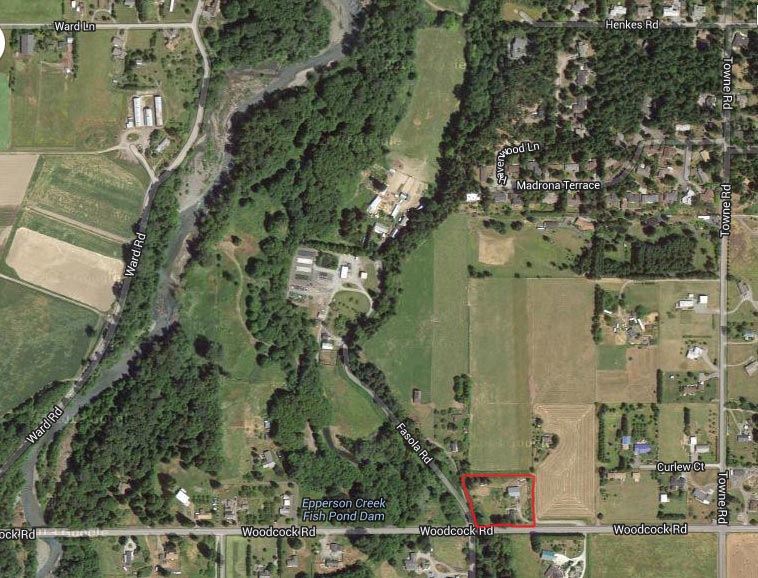[Link back to Site Analysis; Link back to Permaculture Journey]



Property Description:
Barbolian Fields is located on the Olympic Peninsula of Washington State, USA, in a rural area about 4 miles NW of the town of Sequim (population: ~6,600 people; surrounding area: ~25,000).
Distance to Coast: 3.5 miles
Elevation: 101.7 feet
Coordinates: Latitude North 48° 12’; Longitude West 123° 14’
Climate Summary:
Temperate / Mediterranean characterized by wet winters and springs with moderate temperatures, and dry, relatively cool summers. Average rainfall is just 17”, which classifies this coastal region as semi-arid. The area is also characterized by coastal influences of frequent strong winds, high humidity, and seasonal low-lying fog.
- USDA Zone 8a (10 degree F minimum temperatures).
- Last Average Frost: April 15-May 1.
- First Average Frost: October 18-November 10.
- Average number of growing days: 225
Property Aspects:
The project site is approximately 2 acres in size, rectangular shaped, running east-west. It is surrounded on two sides (north and east) by alfalfa/grass fields mown for hay. The northern side is seasonally leased to beef cattle grazing and production. The land is relatively flat, but drops abruptly on both the southern western sides: to the south is the main highway and to the west, a private road and driveway that does not provide access.
Within the property itself, to the east is a traditional orchard comprising 6 old apple trees, 3 pie cherries, and an Italian prune. The southern side is a narrow strip of land between the house and road that extends into an open area bordered by Himalayan blackberry brambles that wrap around the edge of the property to the west. The western edge drops abruptly, also covered with brambles. In the northwest corner are several old cedars, Douglass firs, and an elderly vine maple. The northern side is bordered by a handmade split-rail fence to separate the property from the irrigation ditch that runs along the neighbor’s southern edge. This side is relatively untouched and has become the main area for the honeybee hives; on the neighbor’s side is a dense strip of invasive Canadian thistles.
The property was part of an old dairy farm at the turn of the century. It has two main structures located on the eastern end: a 100+ year-old house with a footprint of 1063 square feet, and what was once a dairy barn, rebuilt in 1996 using pole construction over the original concrete foundation. The barn has a footprint of 2060 square feet and offers a large roof area for water capture and a potential site for future solar panels. Unfortunately, the house is not oriented in such a way to take advantage of solar energies and is shaded on the southern and western sides by large trees.
Access:
The main rural road (Woodcock Rd.) runs along the southern edge of the property. A driveway enters from the southeast edge and turns into a main utility area between the house and barn, just west of the orchard. There is no permanent access to other areas of the property, although vehicles have been used along the north side of the barn. There is also a road on the western border of the property, but it does not provide access to the property itself.
Practical Aspects:
Stakeholders: The owners are in their 50s/60s; one is a marine biologist; the other a gardener/entrepreneur with a professional background in marketing and technical editing. Between them, they have 5 children and 6 grandchildren, who all live nearby and frequently get together for family gatherings. Although committed to gardening, beekeeping, and assorted home-based activities, the owners would like to do more traveling before settling down with the commitment of small farm animals.
Finances & Approach: In terms of finances, some of the ideas presented in Phases 3-4, particularly, are outside the scope of what the owners want to spend; they feel, however, that with a bit of creativity, these projects can still be accomplished, although possibly not within the ideal timeframes presented in this design. Many of the house retrofits or solar technologies, for example, could easily consume the entire budget. Therefore, most of the projects will be do-it-yourself by the owners as finances allow and using upcycled materials whenever possible. Most of the garden / landscaping work is done with hand tools (scythe, shovel, hoe).
Challenges: The difficulty in this project is that it is already a work in progress – so the plan is being implemented at the same time it is being refined. The owners purchased the property in 1995 and started transforming it from an old field that had been used for grazing cattle and then left vacant for decades to a place for housing several llamas and growing a family garden. When the llamas died of old age, they were not replaced; instead, the owners started expanding the garlic-growing operation and other food gardens, capturing rainwater, and looking at ways to build a more self-sufficient homestead. With backgrounds in environmental science, the owners feel a strong commitment to sustainable practices; permaculture ethics are in direct alignment with their beliefs. Their primary objective is to transform what has been a monocrop approach (in the orchard, hay fields, garlic business) to something that more resembles a complete ecosystem in support of honeybees, other pollinators, and assorted wildlife, including those of the Homo sapiens variety.